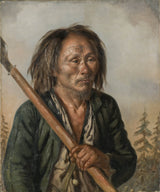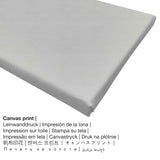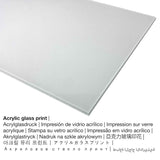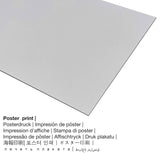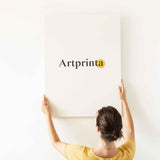Carl Peter Mazer, 1850 - Eserese nke asụsụ nwoke - mbipụta nka mara mma
Ụtụ gụnyere. Mbupu gbakọrọ na ndenye ọpụpụ.
Nchịkọta nke ngwaahịa
Portrait of a Man Tongue bụ nke nwoke na-ese ihe Carl Peter Mazer n'afọ 1850. E sere ihe mbụ na nha: Ogologo: 55 cm (21,6 ″); Ogologo: 57,5 cm (22,6 ″) ma jiri usoro ihe arụpụtara ya mmanụ na kwaaji. Ọzọkwa, a pụrụ ịhụ ihe osise ahụ n'ime National Museum nke Stockholm nchịkọta. Site n'ikike nke - Nationalmuseum Stockholm na Wikimedia Commons (ikike - ngalaba ọha).: . Nhazi ahụ bụ Eserese na nha onyonyo nke 1: 1.2, nke pụtara na ogologo bụ 20% mkpụmkpụ karịa obosara.
Akụrụngwa ị nwere ike iburu
N'ime menu ndọpụta ngwaahịa ị nwere ike ịhọrọ nha na akụrụngwa nke gị. Họrọ nha na ihe kacha amasị gị n'ime nhọrọ ndị a:
- Mbipụta kanvas: A canvas print is a printed canvas stretched on a wooden frame. A canvas print of this masterpiece will let you turn your fine art print into a large size work of art as you would see in a gallery. Canvas Prints have the advantage of being relatively low in weight, which means that it is easy to hang up your Canvas print without the support of additional wall-mounts. A canvas print is suitable for all kinds of walls.
- Mpempe akwụkwọ (ihe kwaaji): A poster is a UV printed sheet of canvas paper with a slight surface structure, which resembles the original work of art. It is optimally suited for placing your fine art print with the help of a customized frame. Please bear in mind, that depending on the size of the poster print we add a white margin 2-6cm round about the painting to facilitate the framing.
- Bipụta na iko acrylic na-egbuke egbuke (nke nwere ezigbo mkpuchi iko): The acrylic glass print, often described as a an art print on plexiglass, will change the original work of art into wonderful home décor. In addition to that, it is a viable alternative to aluminium or canvas fine art replicas. The work of art will be manufactured with the help of modern UV direct printing machines. With an acrylic glass art print contrasts and smaller details become recognizeable thanks to the very fine tonal gradation of the picture. The acrylic glass protects your chosen art replica against light and external influences for several decades.
- Mbipụta nke aluminom: An Aluminium Dibond print is a material with a true depth effect. Its non-reflective surface structure make a modern impression. The print on Aluminum Dibond is the most popular entry-level product and is a contemporary way to display fine art reproductions, since it draws attention on the whole artwork.
Ihe dị mkpa: We strive to depict the products as clearly as possible and to demonstrate them visually. Still, the tone of the print products and the imprint might differ somehwat from the presentation on the screen. Depending on your screen settings and the condition of the surface, not all color pigments can be printed as realistically as the digital version depicted here. Considering that the art reproductions are printed and processed manually, there might also be minor variations in the size and exact position of the motif.
Banyere ihe a
| Bipụta ụdị ngwaahịa: | ọrụ mgbidi |
| Usoro mmeghari: | dijitalụ mmeputakwa |
| Production usoro: | Mbipụta UV ozugbo (mbipụta dijitalụ) |
| Nlụpụta: | arụpụtara na Germany |
| Stockdị ngwaahịa: | na mmepụta ihe |
| Ngwaahịa were: | foto mgbidi, ihe ndozi mgbidi |
| Nhazi onyonyo: | usoro eserese |
| Oke akụkụ: | ogologo ruo obosara 1: 1.2 |
| Nsonaazụ: | ogologo bụ 20% mkpụmkpụ karịa obosara |
| Nhọrọ ihe: | acrylic glass print (nwere ezigbo mkpuchi iko), mbipụta akwụkwọ mmado (akwụkwọ kwaaji), mbipụta kanvas, mbipụta ọla (aluminium dibond) |
| Nhọrọ nha nha mbipụta kanvas (akwa akwa na etiti ihe ndọtị): | 50x60cm - 20x24", 100x120cm - 39x47", 150x180cm - 59x71" |
| Mpempe iko acrylic (nwere ezigbo mkpuchi iko) nha dị iche iche: | 50x60cm - 20x24", 100x120cm - 39x47", 150x180cm - 59x71" |
| Mpempe akwụkwọ mmado (akwụkwọ kwaaji) nha: | 50x60cm - 20x24", 100x120cm - 39x47" |
| Nha ebipụta aluminium dibond: | 50x60cm - 20x24", 100x120cm - 39x47" |
| Igwe onyonyo: | agunyeghi |
Ozi ndabere gbasara ọrụ nka mbụ
| Aha ọrụ nka: | "Portrait of a Man Tongue" |
| Nhazi: | sere |
| Okwu mkpokọta: | nkà nke oge a |
| oge: | 19th narị afọ |
| Afọ okike: | 1850 |
| Afọ nka: | ihe karịrị afọ 170 |
| Agba na: | mmanụ na kwaaji |
| Akụkụ nke ihe osise izizi: | Ogologo: 55 cm (21,6 ″); Ogologo: 57,5 cm (22,6 ″) |
| Egosiputara na: | National Museum nke Stockholm |
| Ebe ngosi nka: | Stockholm, Obodo Stockholm, Sweden |
| Weebụsaịtị ihe ngosi nka: | National Museum nke Stockholm |
| Ikikere nke ihe osise: | ngalaba ọha |
| Site n'aka: | Nationalmuseum Stockholm na Wikimedia Commons |
Nchịkọta ihe nkiri
| Ihe nkiri: | Carl Peter Mazer |
| Aha ndi ozo: | Carl Peter Mazer, Mazer Carl Peter, Mazer Karl, Mazer Karl Peter |
| okike nke onye nka: | nwoke |
| Nationality: | Swedish |
| Ọrụ onye na-ese ihe: | onye na-ese foto, onye na-ese ihe |
| Mba onye si: | Sweden |
| Nkewa onye nka: | omenkà nke oge a |
| Oge ndu: | 77 afọ |
| Afọ ọmụmụ: | 1807 |
| Amụrụ na (ebe): | Stockholm, obodo Stockholm, Sweden |
| Nwụrụ n'afọ: | 1884 |
| Nwụrụ na (ebe): | Naples, mpaghara Napoli, Campania, Italy |
Nwebiisinka © | www.artprinta.com (Artprinta)
Ihe ngosi nka sitere na ụlọ ngosi nka (© - nke Nationalmuseum Stockholm - National Museum nke Stockholm)
English: Mazer's career is one of the more remarkable among Swedish 19th century artists. In the late 1830s he travelled via Finland to Russia where he was to spend much of his life. In Russia he learnt how to take photographs and also opened a photographic studio in Moscow. Around 1850 he travelled from Russia to China. This portrait of a Tungu man, from one of the Mongolian tribes in Siberia, was probably painted during this journey. Målningen föreställer en man med ett tatuerat eller målat mönster i ansiktet. Han är bar på överkroppen och håller ett spjut i sin vänstra hand. I bakgrunden står summariskt framställda granar mot en gul och blå himmel under skymning.

